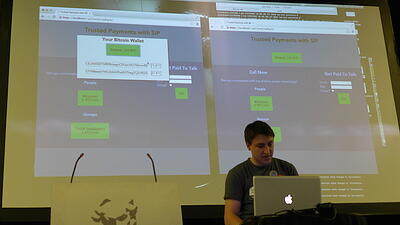2014 was a big year for WebRTC. Between technical advancements, wider implementation, and broader user bases, WebRTC has flourished remarkably throughout its fledging ecosystem and beyond. Here we offer a collection of some of the more noteworthy WebRTC happenings in 2014. What will 2015 bring for the growing technology? Stay posted on our blog to keep up with the latest WebRTC news.
January
1/29 - IETF assigned an RFC number to the SIP WebSocket specification, a drafted document to standardize transporting SIP signaling using HTML5's realtime WebSocket API.

February
2/03 - RTCDataChannel is used prominently in Pipe, an app that transfers large files within Facebook, taking advantage of WebRTC's peer to peer framework.

Breaking with streaming real-time communications apps, Pipe uses WebRTC P2P to transfer files
March
3/6 - Following in the mobile trends of Chrome and Firefox, Opera 20 adds support for the WebRTC APIs in its desktop and Android browsers.
3/31 Video chat marketplace LiveNinja launches Katana for businesses to connect with customers via live video, audio, screen-sharing and text-based chat.

April
4/28 - The OnSIP Network is released, a signaling Platform as a Service (PaaS) for developers to quickly and easily build WebRTC applications in scale.
May
5/1 - OnSIP releases the InstaCall solution, a hosted PBX feature that interlocks a mature VoIP architecture with WebRTC, offering instant voice and video calls in a single mouse click.
5/2 - Snapchat acquires AddLive, a WebRTC based video chat company, to help build and power its new cross-platform service.
June
6/6 - OnSIP Lead Developer Will Mitchell presented his own work entitled "Trusted Payments With SIP", a method of producing secure BitCoin transactions using SIP.js and WebRTC at TADhack in Madrid.

OnSIP Lead Developer Will Mitchell presents his SIP-based BitCoin application
6/17 Priologic releases first open source WebRTC plugin for Internet Explorer at WebRTC IV Conference and Expo.
July
7/8 - The first public build of SIP.js, a customized SIP JavaScript stack for WebRTC developers, is released.

September
9/4 - Firefox Beta gets built-in WebRTC video calls on desktop, Chromecast, and Roku Video Casting on Android.
9/16 - GENBAND releases Kandy, the WebRTC-based communications platform that comes with APIs, a mobile SDK and a range of SaaS capabilities.
October
10/21 - W3C publishes a recommendation from the Web Real-Time Communications Working Group called the Identifiers for WebRTC's Statistics API, a set of Javascript APIs that allow access to the statistical information about a PeerConnection.
10/28 - InstaPhone for Salesforce is released, combining advanced CRM and instant in-browser voice and video calls directly within the Salesforce platform.
10/31 - Ericsson's Bowser is accepted to Apple's App store at the end of October, making up for the lack of a WebRTC-compatible browser in iOS.
November
11/3 - Android L launches with a WebRTC-enabled WebView, allowing for hybrid apps.
11/16 - Mozilla CTO Andreas Gal cites in his blog that Mozilla worked with Cisco and now supports both H.264 and VP8 in Firefox.
11/16 - Microsoft implicitly embraces WebRTC through Skype for Web (Beta), a WebRTC-based Skype app.
December
12/20 - Oracle Communications WebRTC Session Controller 7.1 is released, bringing WebRTC support to native mobile iOS and Android applications.
12/24 - TokBok powers Firefox Hello, an in-browser WebRTC client offering voice and video calls within Firefox 34.

